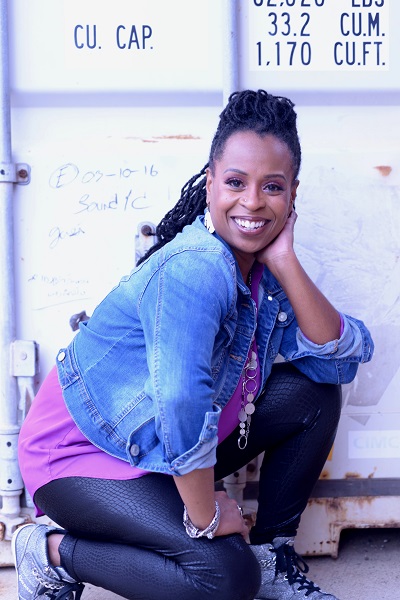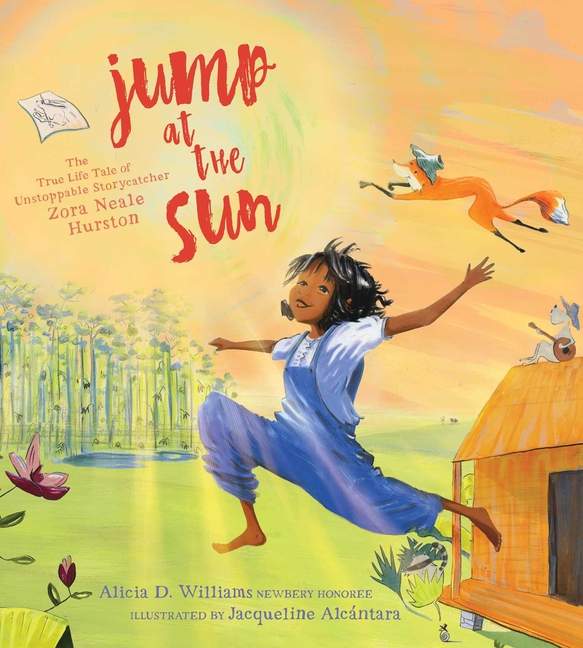From Teaching to Writing

TeachingBooks asks each author or illustrator to reflect on their journey from teaching to writing. Enjoy the following from Alicia D. Williams.
It’s all funny—me teaching and writing—since I feel as if I fell into both.
I was (and still am) a teaching artist of arts-integration. During residencies, I infused drama, improvisation, movement, and storytelling to help teachers incorporate art into their curriculum. That was the best. I was able to spend one to three weeks with a school and leave a rock star! Almost always, the teachers wanted a written piece which culminated into a presentation at the end.
Some examples of the residencies include biography and wax museum units, creating a poem to lift student and school morale, studying Cinderella from different cultures and writing a script, making photo tableaus from long tales and creating new ones based off the pictures, dramatizing folktales and writing new endings. For my WolfTrap training, I’d go into pre-K classrooms for fourteen lessons, and I’d engage Littles with a story using Coffee Can (or Shoebox) theatre, puppetry, movement, chanting, imagination, etc. Teachers would tell me how their students can recall the story, make predictions, and even make-up new chants and games based from my lessons.
When money dried up for the residencies, I became a teacher’s assistant. This was during the time that I was in graduate school for writing, so I was able to not be mentally exhausted to work. I’ve supported fourth grade, kindergarten, the art teacher, and even covered high school English for five months. During my time in the school system, I taught middle school history for one year, both Ancient and US History, and this happened to be when Genesis Begins Again was published. I couldn’t do both—too much grading, emails, meetings, planning, etc during the day and much more emails, traveling, speaking requests, and writing after hours. I thought it would be a plush deal to go back to being an assistant but realized that it was still too much to manage.
I like to think that this journey—teaching artist, assisting, lead teaching, and writing—influenced each other.
Genesis Begins Again began while in graduate school. While I drew on memories from growing up, how I felt as a shy middle-schooler, how friends treated each other, how I felt being a new kid, and how light skin kids were complimented and not the darker skin ones. I do believe other experiences seeped into the story as well. I’d already been in so many classrooms with my residencies—classrooms where teachers were limited in how many copies they could make, classrooms where many came from the homeless shelter next to the school, and classrooms where the PTA could afford to fill the auction baskets with Nintendo’s and expensive games. All different socio-economic levels. And certain memories still resonate with me. How students teased one another, their language and slang, insecurities about themselves and friendships—these observations were stored in my memory and found subtle ways to wiggle into my characters.
All those times storytelling and getting students to use vocal expression played out in the rhythms of the prose.
When writing my picture book biography, Jump at the Sun: The True Life Tale of Unstoppable Storycatcher Zora Neale Hurston, I channeled the way I’d play with story and repetition during my WolfTrap lessons. All those times storytelling and getting students to use vocal expression played out in the rhythms of the prose. I recalled how students would write their wax museum biographies in a linear forced way: Hi, my name is ______. I was born ____. I did this______ and this _____. And I died _____. I would cringe, I’m like, “No, you can’t say that you’re dead if you’re pretending to be the person.” Instead, I would get them to take the research text and ask: Who is this person and why are they so important that we should remember them? Then, once they had that, ask: What challenges did they face? How did they handle them? What were their moments of triumphs? Were there any who helped them or tried to stop them? Asking these types of questions made the person feel more real, more personable, and students were able to identify with them more. And all of this, I brought to writing about Zora.
My classroom experience allows me to find ways to engage students during my school visits. My regret is that most times schools want to only discuss my writing process or about the book, and I’m wanting to do so much more. Which, I understand, because funding doesn’t allow for residencies and time doesn’t allow for me to go deeper. It’s just me . . . I crave my teaching artist days.
Now, as I write new stories, I will still think of specific students, moments, conversations, and lessons. I’ll recall moments when I felt I reached students as well as disappointed them and write from an adult’s perspective as well as put myself in their young shoes. I can take their anxiety—trust me, there was so much anxiety around quiz and test days—to be perfect, to be accepted, to be “normal” and use it. These are all gifts. Gifts that students gave to serve my writing, and gifts that my stories offered to my students.
Books and Resources

TeachingBooks personalizes connections to books and authors. Enjoy the following on Alicia D. Williams and the books she’s created.
Listen to Alicia D. Williams talking with TeachingBooks about the backstory for writing Jump at the Sun. You can click the player below or experience the recording on TeachingBooks, where you can read along as you listen, and also translate the text to another language.
- Listen to Alicia D. Williams talk about her name
- Explore TeachingBooks’ collection of activities and resources for Jump at the Sun
- Explore TeachingBooks’ collection of activities and resources for Genesis Begins Again
- See a Discussion Guide for Genesis Begins Again
- Discover Alicia D. Williams’s page and books on TeachingBooks
- Alicia D. Williams on her website, Instagram, Facebook, and Twitter.
Explore all of the For Teachers, By Teachers blog posts.
Special thanks to Alicia D. Williams and Simon & Schuster for their support of this post. All text and images are courtesy of Alicia D. Williams and Simon & Schuster, and may not be used without expressed written consent.



Leave a Reply